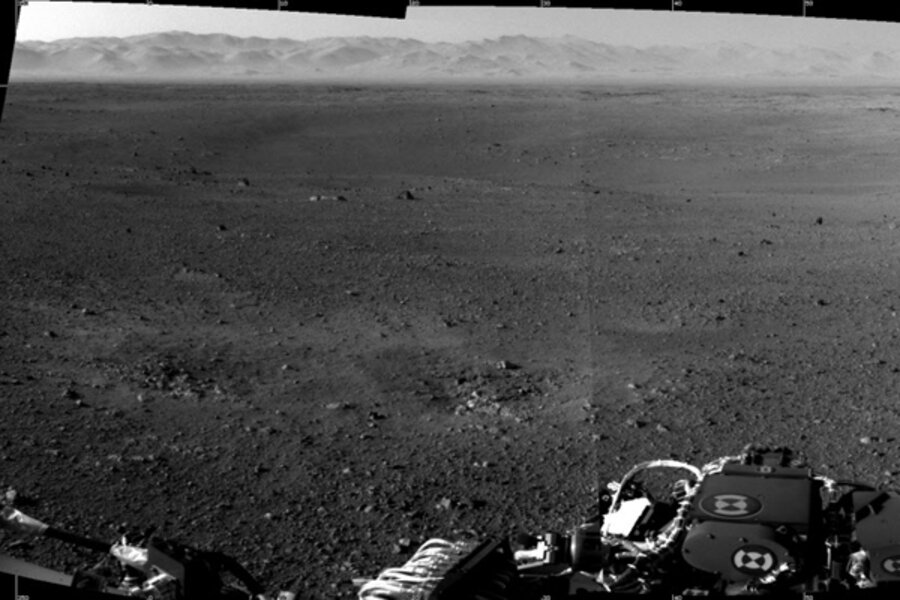Hey, is that Mars or the Mojave in NASA rover's photo?
Loading...
It could be an old postcard from Earth – a detailed black-and-white picture showing a barren, subtly undulating landscape stretching to a mountain range in the distance.
Looking at the scene, "you would really be forgiven for thinking that NASA was trying to pull a fast one on you and we actually put a rover out in the Mojave Desert and took a picture," complete with "a little L.A. smog coming in there," quips John Grotzinger, a researcher at the California Institute of Technology in Pasadena and the Mars Science Laboratory mission's project scientist.
But this isn't the Mojave. It's Mars. Specifically, the interior of Gale Crater, with the crater's north rim rising in the distance.
As it examined the photo, the science team marveled at how Earth-like the scene appears, Dr. Grotzinger says. It's among the first images from the navigation camera mounted atop the rover's newly erected mast.
The scene's familiarity hints at why NASA is spending $2.5 billion on the Mars Science Laboratory mission. Mars is Earth-like in many ways, but seemingly is barren of life. Curiosity is designed to help scientists determine whether, in Mars’ distant past, this 3-billion to 4-billion-year-old crater hosted an environment where life could have gained a foothold.
Now heading into its third Martian day, or sol, Curiosity has been performing virtually flawlessly as engineers carefully begin flexing its motorized joints and activating cameras and instruments.
Engineers have finished aiming the rover's high-gain antenna toward Earth. Curiosity has fully extended its camera mast, whose three different camera systems sit seven feet above the Martian surface. Engineers are well on the way toward fixing a software glitch with the rover's on-board weather station. And while the interior of the rover is a tad warmer than the engineering team expected, that extra heat will not affect the performance of Curiosity's science packages.
Indeed, the extra warmth may turn out to be helpful, said Jennifer Trosper, mission manager for the Mars Science Laboratory, at a briefing Wednesday. It means the rover will require less energy to warm actuators needed to drive around and to move the rover's seven-foot-long arm. The arm collects rock and soil samples and transfers them to the chemistry lab inside the rover. It also hosts an X-ray device for analyzing minerals in rocks and a small camera that serves as a geologist's magnifying glass.
The rover's radiation monitor – designed to measure cosmic rays and the effects of solar storms on the surface – has started returning data. The data will give mission planners a better idea of the radiation hazards astronauts would face on Mars. And scientists will combine Curiosity's radiation data with similar measurements taken at the top of the atmosphere by MAVEN, an orbiter slated for launch in November 2013 that aims to answer questions about the disappearance of what is thought to have been a denser atmosphere early in Mars' history.
Analysts looking at additional images from the Mars Reconnaissance Orbiter's overflight of the landing area found the impact locations for six tungsten weights the rover's entry vehicle ejected at is descended – an action vital to the successful operation of Curiosity's self-guided descent stage. The pattern of impact scars and their trajectory after they were released will provide useful information about the atmosphere's condition when the rover began its descent.
Still, it comes as no surprise that images from the rover steal the show.
In addition to the landscape image that captivated the science team, the navigation camera returned thumbnail images that provide the first slice of a 360-degree panoramic view of Curiosity's surroundings that the camera will provide over the next day or two.
Until the panorama arrives, however, the postcard is giving scientists plenty to think about.
The north rim is the source of an alluvial fan – sediment washed downslope – that researchers would like to investigate, since habitability requires the presence of liquid water.
"All those materials derive from erosion of those mountains," Grotzinger says. "You're looking toward the watershed that delivered those materials."
Much closer to Curiosity – literally within a few lengths of the rover's seven-foot-long arm – are scars left by the descent stage's rocket engines. The exhaust brushed aside a thin layer of soil to reveal what the researchers say is bedrock.
Typically, rovers have had to scratch away surface material with their wheels to reach lower layers.
"Here we get a freebie," Grotzinger says. "We see our first glimpse of bedrock."
The crater's Mojave-like look "makes you feel at home," Grotzinger says. "We're looking at a place that feels real comfortable. What's going to be interesting is to find out all the ways that it's different."





